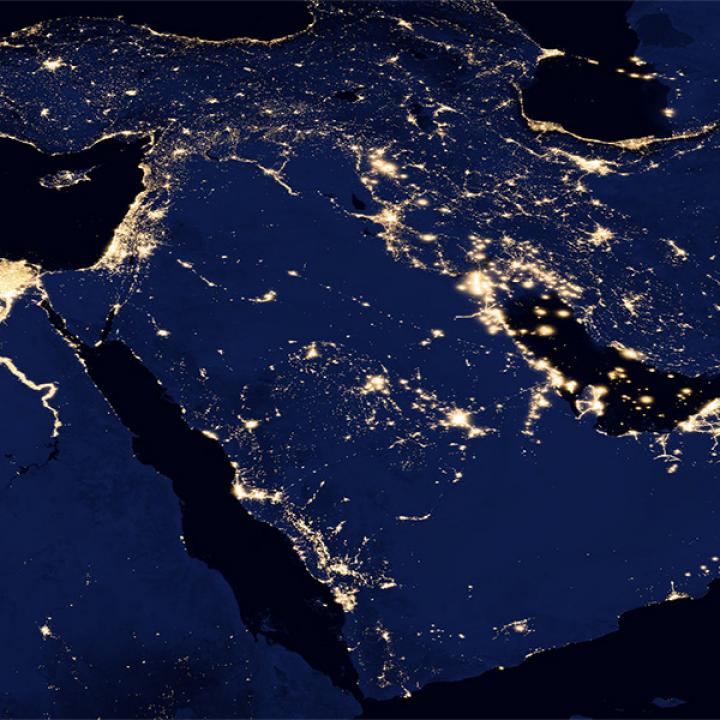

As tumultuous as the region's recent struggles have been, they have also exposed opportunities to establish a more multilateral Middle Eastern security architecture via renewed U.S. leadership.
In the past five years, the Middle East has suffered from a double collapse. First, having proven unable to provide capable political institutions or economic opportunity to their citizens, several of the region's states have effectively collapsed. Reconstituting them has proven to be a task of immense difficulty, leading to increased repression and violence in Egypt, the fragmentation of Syria and Iraq along sectarian lines, and anarchy in Libya and Yemen. The political and economic decay of these states is not a new phenomenon, and was not triggered by the Arab uprisings of 2011. Rather, that tumult exposed and ultimately exacerbated deep structural problems that were decades in the making.
Second, the security architecture of the Middle East has collapsed. Since the 1991 Gulf War, that architecture had been based on a robust American forward presence in the region, supported by strong, if mostly undemocratic, allies. Together, they were committed to a U.S.-led strategy revolving around heavy American economic and security support and active Western intervention to counter regional spoilers, exclude other hegemons from outside the region, and otherwise preserve the status quo.
The U.S. strategy began to change with the 9/11 attacks, which led Washington not only to focus more heavily on counter-terrorism, but also to question whether the regional status quo -- particularly the absence of meaningful political and economic progress in the Middle East -- was in fact satisfactory and sustainable. While this discomfited U.S. allies in the region, their primary objection was to the 2003 Iraq War, which they saw as empowering Tehran and contributing to regional instability.
An even more fundamental shift has taken place under the Obama Administration. A combination of war fatigue, the financial crisis, energy self-sufficiency, and a desire to shift focus to Asia contributed to a scaling-back of American strategic engagement in the region. This was demonstrated most concretely by what regional allies saw as a precipitous U.S. withdrawal from Iraq in 2011 and by America's failure to act on its Syrian chemical weapons "red line" in 2013. At the same time, President Obama's focus on improving relations with Iran altered the nature of that engagement. The U.S. had effectively set aside its longstanding strategy but articulated no clear replacement. The result, when combined with the ouster of U.S. allies in Egypt and elsewhere, was the collapse of the region's security architecture.
Together, these twin collapses created a vacuum. The unraveling of governments and institutions created an opening for malign actors, ranging from ISIS and likeminded groups, which have established or expanded footholds in every one of the region's conflict areas, to Iran, to opportunistic outsiders such as Russia. With the U.S. hesitant to act or effectively build regional coalitions, the region's powers have formed their own ad hoc blocs around loosely shared worldviews, strategies, or interests. These blocs have jockeyed for preeminence using the capabilities available to them -- including both proxies (as in Syria) and direct intervention (as in Yemen) -- often without consultation with Washington. They have also sought to diversify their international ties, turning increasingly to Russia and China, in order to increase their room for maneuver and hedge their bets against unpredictable U.S. regional policy.
A return to the regional status quo ante is unlikely: ISIS is entrenched and, like al-Qaeda, its ideology may persist in a new manifestation even if the group itself is dismantled; Syria and Iraq have become internally polarized and are unlikely to return to their former structures; Iran has been empowered by the nuclear deal; Russia and China are increasingly active in the region; and the economic and political stresses that contributed to the 2011 uprisings not only persist but in many cases have worsened, save in a few states that have made serious reform efforts.
The next U.S. President will need to confront these realities and design a strategy around them. Some elements of the old American strategy are worth reviving -- for example, a clearer and more concerted effort to counter Iran could contribute to regional stability and bolster the confidence of U.S. allies. Other elements must be revisited in response to decades old failings. For example, the past five years make clear that promoting economic and political reform to improve the resiliency and responsiveness of state institutions is in the U.S. interest.
As tumultuous as they have been, the region's recent struggles have also exposed opportunities, such as an increased willingness on the part of U.S. allies to act in concert with one another in response to mutual threats. If effectively combined with renewed U.S. leadership, this could serve as the foundation for a new, more multilateral regional security architecture.
Finally, whatever its particulars, any new U.S. strategy must be a long-term one, with bipartisan political buy-in in Washington, lest American policy in its unpredictability add to rather than mitigate the region's risks. The Middle East has a reputation for being impervious to change, which recent years have demonstrated to be ill-deserved. It is a region awash in change; to effectively address its problems, its leaders and American policymakers must demonstrate that they too can adapt.
Michael Singh is the Lane-Swig Senior Fellow and managing director at The Washington Institute.
Cipher Brief

